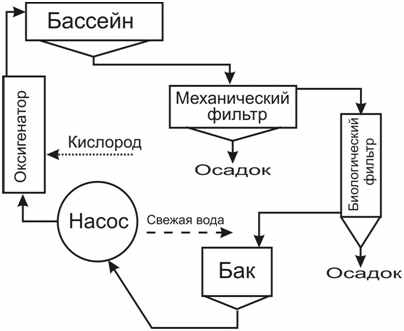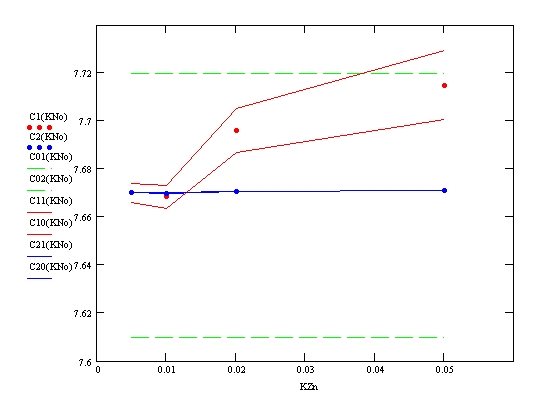
ICWS represents the closed system intended for maintenance of optimum conditions of ability to live of water organisms [1]. Application ICWS in industrial fish culture gives a number of conclusive advantages in comparison with classical methods, such as cultivation of fish in ponds.
Use of the fish-breeding installations closed on water allows to avoid seasonal fluctuations of temperature.
Own raw-material base more and more dies away every year, and indicators of manufacture do not contain optimism. Revival of a raw-material base and creation own aquaculture can become an exit from the given position. Use of installations of the closed water supply for cultivation of fish can become one of such exits.
Quality of a surface water not always corresponds to the norms accepted for fish culture because of their impurity by products of ability to live of the person, agricultural animals and manufacture. Besides, quality of a surface water changeably as it is influenced by floods, a storm, not planned emissions of the enterprises, etc. Thus it is necessary to address even more often to independent installations to these factors [2].
Recently use ICWS in industrial fish culture – the most perspective world tendency. At cultivation in the closed installations all parametres of technological process (water air-conditioning, feeding, control and etc.) are carried out by means of the automated devices which action can be programmed. Influence of natural factors on a course of technological process becomes minimum.
One of the important parametres influencing development and cultivation of fish as a whole are such parametres, as temperature and concentration of the dissolved oxygen in water.
To develop, prove and investigate structure of electronic system which would notify from a deviation from norms of concentration of oxygen for timely introduction of various factors.
For object in view realisation it is necessary to solve following problems:
- A substantiation and research of installation of the closed water supply on controllable parametres and the processes occurring inside;
- The analysis of existing methods and control devices of concentration of the dissolved oxygen in water;
- Research of a method of measurement of concentration of the dissolved oxygen in water with use of the luminescent gauge;
- Research of various factors on an error of measurement of the luminescent gauge and construction graduate dependences;
- A substantiation and working out structure the electronic scheme of control of parametres of water in ICWS.
A quality monitoring of such parametres available at present as concentration of the dissolved oxygen in water, have a number of lacks of a various kind that reduces to impossibility of enough timely and exact definition of concentration of oxygen in water. At present there is a process of introduction of installations of the closed water supply for cultivation of fish. Thus introduction of a luminescent method for measurement of concentration of oxygen is necessary for the maximum effect of use of such installations.
ICWS represents the closed system intended for maintenance of optimum conditions of ability to live of water organisms.

Fig. 1 – Block diagramme
ICWS
The description of blocks:
Pool. Represents one or several capacities for the maintenance of fish. The pool should provide possibility of fast waste disposal of ability to live of organisms, the free review, and also exclude traumas of fishes because of roughnesses of a surface or design corners.
The mechanical filter. Serves for rough water treating from insoluble impurity of large and average fraction. The mechanical filter not only clears water, but also serves as a protective barrier to the biofilter.
The biological filter. It is applied to creation of inhabitancy of the microorganisms participating in natural circulation of substances of a reservoir. The biofilter represents the cascade of the flowing capacities filled with stones, a polymeric crumb or other kinds of neutral particles to water of the wrong form. On a surface of these particles there live the microorganisms actively absorbing and decomposing products of ability to live of fishes, dissolved in water, first of all nitrites.
The intermediate tank serves for mixed the fresh water compensating evaporation. The various chemical additives applied to maintenance of hydrochemical balance of water, also are entered on this knot.
The water pump creates a water pressure in system, providing its circulation. It is necessary also for work of the most productive installations of saturation as oxygen.
Installation of saturation by oxygen is mounted directly ahead of pool to provide demanded level of saturation О2. At high density of landing of fish in pool additional saturation by oxygen - one of the major aspects of work ICWS.
In the course of research of the given method and several concrete gauges it has been revealed that the given method is exposed to influence of the various substances consisting in water ICWS, and is sensitive to physical and chemical parametres of water ICWS.
Similar researches have been spent and for influence of concentration of zinc in water and concentration of nitrites in water (NO2).
Processing of the received results of measurements has been spent.
1. On the basis of quantity of measurements in one series average value of size of concentration of the dissolved oxygen is calculated.

, где
Where n – kol-in measurements; xi - the received sizes of researches of concentration.
2. The average square-law deviation for each series of experiences is calculated.

3. The
confidential interval for results of method LDO and for results of
the reference device, taking into account factor of Stjudenta
calculated
![]() .
.
![]()
In table 2 the data of one of series of research for studying of influence of temperature (t = 25 0C) are cited.
Table 2.
| № | 1 | 2 | 3 | 4 | 5 | AVE | AQD |
| The dissolved oxygen (in mg/l) LDO | 7.662 | 7.671 | 7.671 | 7.671 | 7.658 | 7.6582 | 9.876*E-3 |
| АНКАТ-7645 | 7.6607 | 7.6602 | 7.659 | 7.6592 | 7.6599 | 7.6598 | 2.909*E-4 |
Dependences of change of accuracy of the indication of measurement of concentration of the dissolved oxygen by the used luminescent gauge and этелонным the gauge are constructed:

Fig. 2 – Dependence of change of concentration of oxygen on temperature

Fig. 3 – Dependence of change of concentration of oxygen on concentration of zinc

Fig. 4 – Dependence of change of concentration of oxygen on concentration of nitrite
(С1- The received average values the luminescent gauge; С2- the received average values the reference gauge; С01, С02- an interval of admissible values of concentration of oxygen; С11, С10 – borders of a confidential interval for the luminescent gauge; С21, С20 – confidential borders for the reference gauge)
On the basis of the received data of research, and also proceeding from the constructed dependences it is possible to draw a conclusion that the given luminescent gauge is astable to changes of temperature, concentration of zinc in water, and in a smaller measure is dependent on concentration of nitrites to water. For the given gauge it is necessary to enter the block of temperature correction and the block of correction from change of concentration of zinc. Thus it is possible to improve its error of measurement considerably.
At a writing of the given abstract магистерская work is not finished yet. Date of definitive end of work: on December, 1st, 2011 the Full text of work and materials on a work theme can be received at the author or its supervisor of studies after the named date.